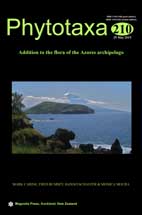Abstract
Goldenrods were first collected in the Azores by the German botanist Karl Hochstetter in 1838 and described as an endemic species Solidago azorica. In 1882, Asa Gray placed the name into synonymy of the American seaside goldenrod, S. sempervirens. The taxonomic position and status of the plants in the Azores remained unclear ever since but recent human-mediated introduction from the American coast seemed to be the most likely explanation. Here, I analyze molecular and morphological data and the historical record to test this hypothesis. While morphological differences are not clear and an overall similarity to some specimens from New Foundland is striking, I find that all analyzed Solidago plants from the Azores archipelago differ in their nuclear ITS and ETS sequences plus a number of microsatellite markers from American goldenrods. Furthermore, the historical record suggests existence of goldenrods in the Azores at the time of the arrival of the first settlers and well before Columbus’ first journey. Moreover, large populations were reported from several islands in the 16th century. I conclude that the Azorean plants are native to the Azores and represent a distinct endemic species sharing a common ancestor with S. sempervirens. The Azorean plants represent a geographically isolated, genetically distinct population that is most likely the result of a natural colonization event from the North American coast perhaps via vagrant birds. I reinstate the name S. azorica and describe the morphological differences between S. azorica and S. sempervirens.

